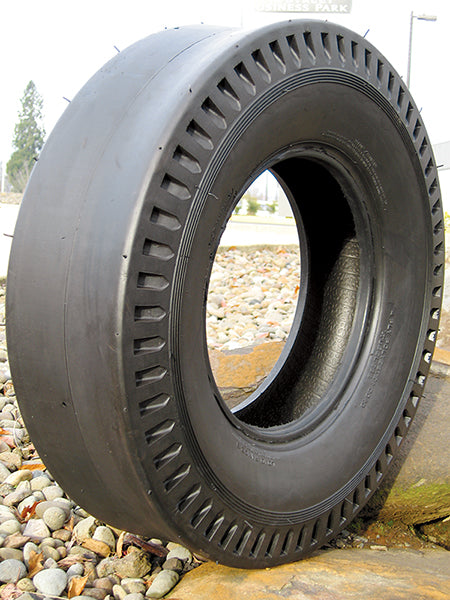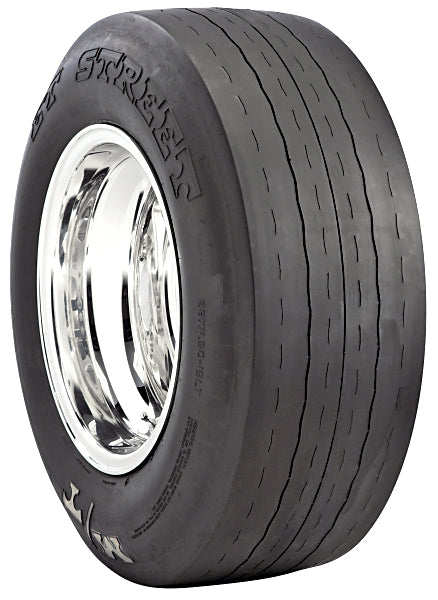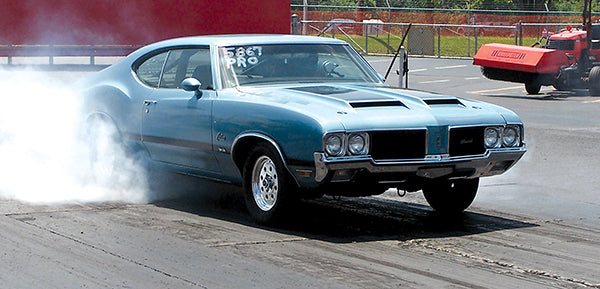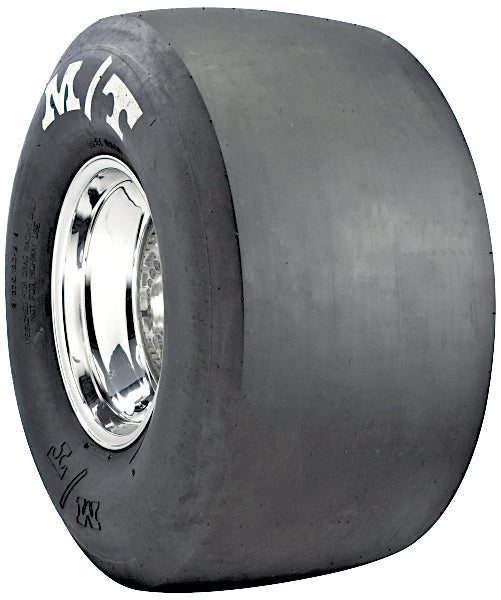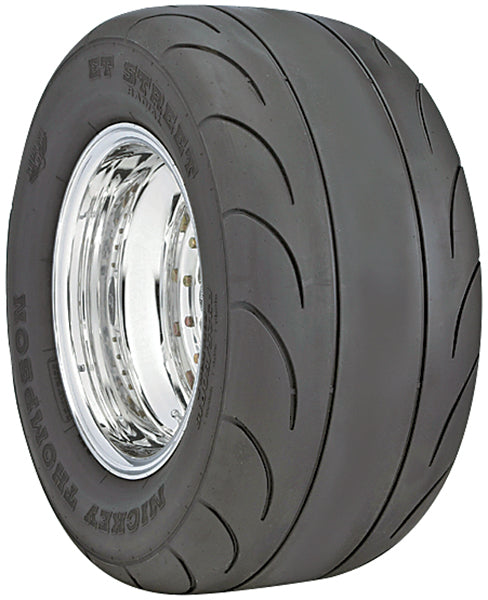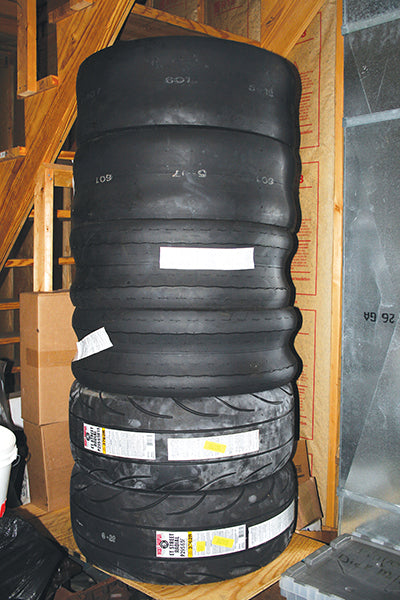Suspension and tire development have been the two greatest contributing factors in the ever-decreasing ETs of the sportsman racing categories. Yes, there are continually many new ways to build additional power too, but that power couldn’t be used if there hadn’t also been stronger and better parts made available. None of these results would have been achieved had it not been for the tires and suspensions that have been developed to handle the power. Drag racing suspensions and drag racing tires have gone hand-in-hand with the evolution of drag racing.
Just as with passenger car tires, several manufacturers specialize in racing tires. I have used just about all of them at some time over the years, including recapped cheater slicks from the 1960s, and don’t have an issue with any of them. The biggest problem I see with racers is not recognizing the fact that when they switch to a different brand of tire they must follow that manufacturer’s guidelines. Each tire maker specifies the type of tire needed, the method for breaking in the tire, and how to get the best-possible results at the track.
This is a recapped racing slick from Hurst Racing Tires. These represented the absolute cutting edge of racing technology in the early 1960s.
On the drag strip, mixing radials with bias-ply tires front to rear (not side-to-side) is allowable, but not recommended for the street. Drag racing is not considered a sustained duration of speed and therefore the poor handling characteristics you experience during normal street driving do not show.
Offset Axle Housings
Sometimes rear axles are not perfectly centered under the car when it’s assembled at the factory, and you may need to run different wheel back spacing on each side if you don’t take the time to center the axle yourself. Depending on how close the tires fit, this may prevent you from swapping tires side-to-side to clean the tread. You can run a wheel spacer on one side to create extra backspacing and still allow for the tires to be swapped side-to-side.
Be sure to check your local track’s rulebook to determine the wheel stud lengths necessary when running aftermarket wheels and/or spacers (if legal).
Rubber Compounds
Racing tires come in many different hardness compounds. Since drag-racing tires have a softer compound than typical street tires, you would think that softer is better. This is not always true. Softer-compound tires are better for a lighter-weight vehicle, while a harder compound tire is better on heavier vehicles. If the compound is too hard on a lighter vehicle, it may reduce traction. If the compound is too soft on a heavier vehicle, it can cause premature wear.
I learned this the hard way in the early 1970s at an NHRA National meet. I was using a very soft compound tire on my 3,800-pound Cutlass, running the Stock Eliminator class. I wore out a set of Goodyear tires in one weekend! This was not Goodyear’s fault, but mine. I learned a lot while experimenting for that ultimate goal of the best ET possible. It was an expensive experiment, but one never repeated. Be sure to follow the manufacturer’s recommendations.
Your car’s transmission also helps determine the compound of the tire needed. Drag tires are designed to either dead hook or have a controlled spin.
If you have a tire that dead hooks, you could get either tire shake or bog the motor when dumping the clutch. Since automatic-transmission cars have a torque converter and don’t launch as violently as clutch-equipped cars, a dead-hook tire works best.
A high-horsepower car with a manual transmission needs a tire that has a controlled amount of spin.
This tech tip is from the full book, HOW TO HOOK AND LAUNCH.
For a comprehensive guide on this entire subject you can visit this link: LEARN MORE ABOUT THIS BOOK HERE
SHARE THIS ARTICLE: Please feel free to share this post on Facebook Groups or Forums/Blogs you read. You can copy and paste the website link: https://www.cartechbooks.com/blogs/techtips/drag-racing-traction-tire-guide
Wheel Screws
If you are running soft compound tires, I suggest drilling the wheels for mounting screws to prevent the tire from turning on the wheel when hooking at the starting line. To install these, mount the tires and inflate them to 25 psi. Before drilling holes and installing the screws into the wheel, be sure they are not so long that they protrude through the tire bead and into the inside of the tire. Racing tires have an extra thick bead where the tire mounts to the wheel to accommodate the screws, and many manufacturers sell the proper-length wheel-mounting screws to accomplish this task without problem. Six to eight screws per side of a wheel is sufficient.
If you are running tubes and a tire spins on the wheel, it can cause the tire to pinch the tube. Whether you are running tubes or not this can not only throw the tire out of balance but also break the bead seal between the tire and the wheel.
If you are not sure if you need screws, you can use a piece of chalk or white shoe polish (common at the track for writing dial-in times on the window glass) to mark a straight line on both the wheel and the tire. When you check this line after making a pass, and it no longer lines up, the tire is slipping on the rim.
Tire Care
One important issue often overlooked is proper care of the tires. The following is a short list of suggestions and conventional wisdom concerning this topic.
Break-in and Rotation
Tires need to be broken in (or “seasoned”). Some tires (like Good-year’s racing tires) are directional until broken in (usually three to eight passes). Serial numbers on Goodyear rear tires must be mounted facing the driver’s side of the car with one facing inboard and the other facing outboard. Goodyear front-tire serial numbers should face the passenger side of the car (also one in and one out). After any brand of rear tire is broken in, they should be rotated side-to-side as frequently as possible. Front tires should not be rotated.
Phoenix racing tires are directional according to the arrows on the sidewall until broken in, which usually takes about 15 passes. BF Goodrich’s drag radials require a final curing process after the tires first hit the pavement. Hoosier and Mickey Thompson tires are not directional, but should be rotated as frequently as possible.
The reason some tires are directional has to deal with the way the seams mate together when the tire is built. Running directional tires in the wrong way can peel the tread off the tire.
This is Mickey Thompson’s current ET Street tire. They are DOT-legal and offer greater traction than the recapped race-only Hurst slick.
Tires need to be rotated frequently because the tread can ball up as it wears. Running tires in the opposite direction gets rid of the balling and smooths out the tread once again. Trying to launch a car on a tire that has little rubber balls all over it is like trying to launch on marbles. If the tires are DOT approved, driving them on the street should also remove the rubber ball buildup.
I suggest rotating your tires every weekend. You will get better traction and a much extended tire life.
Storage
When storing your tires for the off-season, remove them from the car or at least jack up the car to get them off the ground. Drop the air pressure to about 5 psi and keep them out of direct sunlight.
Tires should not be stored around welding areas or high-voltage electric motors. Keep them covered and avoid extreme cold or heat (including heat-generating electric motors, furnaces, air compressors, etc.).
Also, tires should not be allowed to freeze when wet.
Shown is a natural rubber inner tube for use with racing slicks. These are available from Mickey Thompson.
Inner Tubes
Many racers feel that bias-ply drag racing slicks (wrinkle wall) should be run without inner tubes, since that creates a lighter weight mass to rotate. While that is correct, a couple other factors contribute to the decision whether to use a tube or not.
A heavy car that hits the tire hard upon launch might be better off with inner tubes to add strength and stability to the sidewalls, giving less wrap-up and therefore a quicker response time. Additionally, tires equipped with tubes don’t leak air during the week between races. Radial drag racing tires already have a built-in liner and stiffer sidewalls, and therefore don’t need tubes.
Air Pressure
Always run as much air as possible in your rear tires. The more pressure the better. More air creates less rolling resistance and makes the tire roll easier. With too little air pressure, the car tends to drive the wheel into the ground at the starting line, which could pinch the tube and/or debead the tire as well as let the tire cup in the middle of the tread (thus creating two small footprints instead of one larger one).
Also, with too little air pressure, the car tends to sway at higher speeds on the top end of the track. When experimenting with tire pressures, anytime I get that swaying effect, I know I am at least 2 to 4 pounds short of air pressure from what the tire wants, regardless of what is happening at the starting line.
Tread Depth
It is not uncommon for tires to lose grip while still having tread left. I have seen racers with slower cars run their tires (while not recommended) until the cords show, and not notice much reduction in ET. On the other hand I have had customers call needing technical help because their car had slowed down for no apparent reason. First, I ask if their speed has decreased (indicating horsepower level). If not, the next question is how old or how many runs they have on their rear tires. After eliminating other possibilities it becomes apparent that the tread may have worn away.
If you are losing traction and have sufficient tread left, unless you change your burnout method, it will probably happen again at about the same time as with the last set of tires. To increase tire life, do not overheat them (do the minimal burnout you need to get full traction, and no more), and when the tires get a grainy texture on the tread, reverse them to smooth them out again.
After both tires produce steady smoke, stage the car as soon as possible to keep heat in the tires.
A typical tread depth gauge like this one is placed into the holes in the slick’s tread to get an accurate reading. Consult the tire manufacturer to learn your tire’s minimal safe depth.
On DOT-approved treaded tires, use the tread depth gauge in the deepest portion of the tread. Check several places around the tires on both sides of the car to ensure they are wearing evenly.
Mickey Thompson’s ET Drag tires are not DOT-approved and can be used for racing only. These slicks represent the best-possible drag racing tires available, and they work very well.
After each weekend of racing, I always use a tread depth indictor to check the tire’s tread depth in about four places across the tread to be sure I have even wear. If it’s not even, there may be a tire pressure issue. Too much wear on the outside edges indicate that the tires need more air. Too much wear in the middle indicates that the tires need less air. I am talking small changes of 1 to 2 pounds.
Mounting Advice
About 24 hours before mounting DOT-approved street or drag-only tires without tubes, liberally coat the inside of the tire (particularly the inside sidewall) with dish soap. This creates a coating inside the tire to help prevent air leaks through the tire. It also allows the soap to dry in place so the moisture from mounting the tire (air and rim) doesn’t wash soap off any part of the tire. By the way, I have had better luck with Palmolive brand dish soap than other brands.
Most tire shop air compressors have very high moisture content due to running almost constantly. By sure to take your own baby powder or dish soap in case the tire shop doesn’t have any.
Always run as large a tire as possible, both height-wise and width-wise. For the best traction possible, a taller and wider tire has a larger actual foot-print on the pavement than a shorter, narrower tire. Go for the largest foot-print possible unless you are running a low-horsepower engine in a heavy car, which (because of the weight and size of the larger tire) could actually slow down the car. If you have stock wheel wells, you may also have to measure the wheel backspacing clearance carefully before ordering custom wheels to get the largest tire possible into the limited space.
Most non-radial drag tires are suggested to be mounted with tubes. However, using the dish soap method I described it is possible to run a bias-ply drag tire without a tube. It’s always a gamble as to if the dish soap will completely seal the sidewall 100 percent. The good side of not running tubes is weight savings. One pound of unsprung weight is equal to 8 pounds of sprung weight. Therefore, every 12 pounds of unsprung weight removed the car may gain .01 seconds in the quarter-mile. However, on heavy cars the additional sidewall stability from using a tube inside the drag tire may offset the ET lost from weight in traction gained.
Street Tire Comparison
I have had great success using Mickey Thompson (M/T) drag and street tires. If you are contemplating M/T ET Drag tires, ET Street tires, ET Drag Radials, or ET Street Radials, be sure to do your homework before making that purchase. You’re safe with either the ET Drag or ET Drag Radial tires, as they are strictly drag race tires. Not all ET Street or ET Street Radials are 100 percent identical to their Drag counterparts. I recently had an opportunity to test a pair of ET Drag tires (29.5x10.5x15S) against a pair of ET Street tires (30x12.5x15LT). The ET Street tires weigh 26 pounds while the ET Drag tire weigh 27 pounds. Both tires have a 94-inch circumference and a 10.2-inch tread width.
First, I made two passes using the pair of ET Drag tires (29.5x10.5x15S). It was a typical hot, high-humidity Mississippi day with a late afternoon temperature of 96 degrees F. The two passes were very similar in 60-foot ETs, with 1.6059 and 1.5932 seconds. The eighth-mile ETs were 7.0478 and 7.0474 seconds, respectively, with speeds of 98.94 and 98.95 mph, respectively.
Next, I installed the pair of DOT-approved ET Street tires (30x12.5x15LT) and made two more passes. It was about 1 hour and 10 minutes later and the temperature had cooled to about 88 degrees F, with the direct sunlight off the track, creating a much lower track temperature. Again, the two passes were very similar in 60-foot ETs with 1.5364 and 1.5288 seconds runs, respectively. The eighth-mile ETs were 6.9908 and 6.9809 seconds, respectively, with the mile per hour being 98.34 and 98.49.
This tech tip is from the full book, HOW TO HOOK AND LAUNCH.
For a comprehensive guide on this entire subject you can visit this link: LEARN MORE ABOUT THIS BOOK HERE
SHARE THIS ARTICLE: Please feel free to share this post on Facebook Groups or Forums/Blogs you read. You can copy and paste the website link: https://www.cartechbooks.com/blogs/techtips/drag-racing-traction-tire-guide
These ET slips are the result of comparing M/T ET Drag tires (top) to ET Street tires (middle) to ET Street radials (bottom) and displayed in that order with two passes on the same set of tires. The ET Drag tires and ET Street tires are very comparable when you factor in the hour, track temperature, and air temperature. The ET Street Radials with their stiffer sidewall construction and therefore less rolling resistance at the top end made more MPH.
This is Mickey Thompson’s DOT-approved drag radial. These have been the subject of intense research over the past few years, as engineers have been able to find incredible traction while maintaining the relatively stiff sidewall design radials are known for.
Finally, I installed a set of Mickey Thompson DOT-approved ET Street Radials. A couple of hours had passed, since I had to get the tires mounted and make enough suspension changes to feel I was getting an accurate comparison test. The temperature was now down to 76 degrees F and it was dark. Again, the two passes were very similar in 60-foot ETs with 1.5374 and 1.5363 seconds. The eighth-mile ETs were 6.8999 and 6.8992 seconds, respectively, with the speed being 99.66 and 99.69 mph, respectively. I discussed these runs with several racers I knew were running Mickey Thompson Street Radials, and they all agreed that on a car that dead hooks, they should be worth about a .10 decrease in ET with about one more mile per hour.
Although the weather conditions were minimally different on each pair of runs I feel the ETs show that all three pairs of tires can be quite similar in ETs and speed in a typical full-bodied musclecar like mine with 550 to 600 hp and an automatic transmission. With some further suspension testing, I feel the DOT-approved ET Street Radials could have preformed a little better than shown in the ET slip with more top end speed and therefore a quicker ET. Testing on a lighter weight car instead of my 3,800-pound machine should have also shown a better gain on the DOT-approved Street Radials.
Drag Radial Advice
A car using drag radials in the rear yields a quicker ET than the same car with rear bias-ply slick and reach up to 2 mph faster quarter-mile times. However, this is only true for cars that dead hook on that radial tire. Radials are far less forgiving than bias-ply slicks. Due to a drag radial’s stiffer sidewall construction, they do not recover as easily from a spin as will a bias-ply tire. However, if you take the time to set up your chassis to its full potential and can make the car dead hook with no tire spin, this same stiffer sidewall allows the tire to roll easier. This creates a quicker ET on the far end than its bias-ply counterpart. A car using radial slicks that dead hooks could see up to .100 second reduction in ET with most of the gain on the top end. This is all dependent upon getting that radial tire to hook and stay hooked, as recovery from a spin is unlikely.
Run as much air pressure as possible in a drag radial, which is normally in the 18- to 22-psi range, much higher than its bias-ply slick counterpart at 12 psi. One thing often overlooked when switching from a bias-ply slick to a drag radial is that if both tires have exactly the same rollout (to achieve the same top end speed), the drag radial has to turn more RPM than the bias-ply slick. This is because the bias-ply slick grows (due to the tread pushing outward from centrifugal force) at the far end of the track while the radial does not (due to its stiffer construction).
You may want to pick out a drag radial with a 1- to 1½-inch-larger diameter than the bias-ply slick if you don’t wish to turn your engine at a higher engine speed (RPM). Drag race DOT-approved street radials weigh more than a comparably-sized drag slick, but the radial construction has such a low rolling resistance that the extra weight is hardly an issue. Tom Kundrik, a Mickey Thompson race technician and drag radial racer himself, says, “Remember, drag radials do not work on all cars. They are very temperamental and require a lot of experimenting and chassis tuning.”
Tire Storage
Tires should be stored in a dry place, out of the light (especially florescent and sun light), and away from excessive heat and cold. Never leave a tire sitting in water that may freeze. Freezing in water can destroy the tire’s tread and compounds. The sun and florescent lights emit ultra-violet (UV) rays which can destroy the tires compound. It is best to keep the tires covered. Do not store tires near welders, furnaces, or high voltage electric motors which give off ozone which again can destroy the tires compound.
If the season is over and your tires are still in good enough shape to start out the new year, remove the tires from the car or jack the car up so the tires are not on the ground. Leaving them in one place for extended periods of time with the car’s weight on a particular portion of the tire can destroy the tire’s integrity, especially if that tire goes flat and the sidewall is the only thing between the wheel and the surface under the tire. If you run natural rubber tubes as recommended for all non-radial drag tires, this could easily pinch a hole in the tube. Mickey Thompson tires suggest letting the air down to 5 pounds for the storage session.
This is the proper way to stack tires for storage. Notice the much heavier radial tires on the bottom. Thin plywood or very heavy cardboard between the tires spreads weight more evenly, leaving the tires in like-new shape.
If the tires are new and not mounted on wheels, store them any way you want following the above guidelines. Don’t use them as a shelf to store your transmission on while you have your engine out to freshen up. It’s best to keep them in tire racks like at tire stores. But not many of us have that kind of room available or the equipment. They can be stacked on top of each other, as long as they don’t squish the lower tires.
I have gotten new tires mail order and they were tied up into much smaller bundles to reduce the box size needed. Boxes so small you would have never guessed there was a big racing tire in them. They never gave me any trouble. There is a big difference between wading up a new un-mounted tire and wading up a tire at the starting line. If they are stacked up you could put cardboard between them to help distribute the load evenly, but it’s not necessary. They can be stacked up or lying down as long as you follow all of the above examples.
Do not use any chemicals on the tires if cleaning is necessary. To clean the sidewalls only use a mild detergent. Never clean the tread surface.
This tech tip is from the full book, HOW TO HOOK AND LAUNCH.
For a comprehensive guide on this entire subject you can visit this link: LEARN MORE ABOUT THIS BOOK HERE
SHARE THIS ARTICLE: Please feel free to share this post on Facebook Groups or Forums/Blogs you read. You can copy and paste the website link: https://www.cartechbooks.com/blogs/techtips/drag-racing-traction-tire-guide


